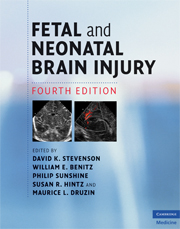Book contents
- Frontmatter
- Contents
- List of contributors
- Foreword
- Preface
- Section 1 Epidemiology, pathophysiology, and pathogenesis of fetal and neonatal brain injury
- Section 2 Pregnancy, labor, and delivery complications causing brain injury
- 5 Prematurity and complications of labor and delivery
- 6 Risks and complications of multiple gestations
- 7 Intrauterine growth restriction
- 8 Maternal diseases that affect fetal development
- 9 Obstetrical conditions and practices that affect the fetus and newborn
- 10 Fetal and neonatal injury as a consequence of maternal substance abuse
- 11 Hypertensive disorders of pregnancy
- 12 Complications of labor and delivery
- 13 Fetal response to asphyxia
- 14 Antepartum evaluation of fetal well-being
- 15 Intrapartum evaluation of the fetus
- Section 3 Diagnosis of the infant with brain injury
- Section 4 Specific conditions associated with fetal and neonatal brain injury
- Section 5 Management of the depressed or neurologically dysfunctional neonate
- Section 6 Assessing outcome of the brain-injured infant
- Index
- Plate section
- References
5 - Prematurity and complications of labor and delivery
from Section 2 - Pregnancy, labor, and delivery complications causing brain injury
Published online by Cambridge University Press: 12 January 2010
- Frontmatter
- Contents
- List of contributors
- Foreword
- Preface
- Section 1 Epidemiology, pathophysiology, and pathogenesis of fetal and neonatal brain injury
- Section 2 Pregnancy, labor, and delivery complications causing brain injury
- 5 Prematurity and complications of labor and delivery
- 6 Risks and complications of multiple gestations
- 7 Intrauterine growth restriction
- 8 Maternal diseases that affect fetal development
- 9 Obstetrical conditions and practices that affect the fetus and newborn
- 10 Fetal and neonatal injury as a consequence of maternal substance abuse
- 11 Hypertensive disorders of pregnancy
- 12 Complications of labor and delivery
- 13 Fetal response to asphyxia
- 14 Antepartum evaluation of fetal well-being
- 15 Intrapartum evaluation of the fetus
- Section 3 Diagnosis of the infant with brain injury
- Section 4 Specific conditions associated with fetal and neonatal brain injury
- Section 5 Management of the depressed or neurologically dysfunctional neonate
- Section 6 Assessing outcome of the brain-injured infant
- Index
- Plate section
- References
Summary
Introduction
Prematurity is a major contributor to perinatal morbidity and mortality in the USA and around the world. Preterm birth is officially defined as delivery occurring prior to 37 completed weeks from the first day of the last menstrual period. The term “low birthweight” is used to describe infants weighing less than 2500 g at birth. This includes neonates who are born after 37 weeks gestational age, of which approximately one-third are in the category of “growth restriction.” This group of neonates is distinct from the group of premature infants, and is the subject of another chapter (see Chapter 7). The discussion in this chapter will be confined to the preterm fetus, that which is delivered between viability (23–24 weeks) and 37 completed weeks of gestation.
Complications of labor and delivery in both preterm and term gestations have been implicated in adverse neonatal outcomes. Traditionally, cerebral palsy and “brain damage” have been linked to intrapartum events that resulted in “birth asphyxia” and subsequent neurologic damage. This association has continued to be proposed despite the fact that current evidence suggests that only about 10% of patients with cerebral palsy, about 1–2 per 10,000 births, experience serious birth asphyxia. Most studies in this field refer to the term fetus. The preterm neonate has its own unique complications and resultant sequelae.
- Type
- Chapter
- Information
- Fetal and Neonatal Brain Injury , pp. 59 - 68Publisher: Cambridge University PressPrint publication year: 2009

